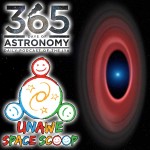Podcaster: Richard Drumm
 Title: Space Scoop: Zombie Stars and the Fate of the Solar System
Title: Space Scoop: Zombie Stars and the Fate of the Solar System
Organization: 365 Days Of Astronomy
Link : astrosphere.org ; http://unawe.org/kids/unawe1546/
Description: Space scoop, news for children.
Bio: Richard Drumm is President of the Charlottesville Astronomical Society and President of 3D – Drumm Digital Design, a video production company with clients such as Kodak, Xerox and GlaxoSmithKline Pharmaceuticals. He was an observer with the UVa Parallax Program at McCormick Observatory in 1981 & 1982. He has found that his greatest passion in life is public outreach astronomy and he pursues it at every opportunity.
Today’s sponsor: This episode of “365 Days of Astronomy” is sponsored by — no one. We still need sponsors for many days in 2015, so please consider sponsoring a day or two. Just click on the “Donate” button on the lower left side of this webpage, or contact us at signup@365daysofastronomy.org.
Transcript:
This is 365 Days of Astronomy. Today we bring you a new episode in our Space Scoop series. This show is produced in collaboration with Universe Awareness, a program that strives to inspire every child with our wonderful cosmos.
Today’s story is:
Zombie Stars and the Fate of the Solar System
In many parts of the world, we’re heaving a big sigh of relief as the scariest part of the year comes to an end. That’s Halloween in case you didn’t know. But the Universe has got one last fright left in store for us – a real-life zombie star!
Braaaaaains!
Sorry…
This isn’t just a costume though, the star at the centre of the artist’s impression in today’s album artwork has actually risen from the dead…and it’s hungry.
When stars with masses like our Sun fuse all their fuel, they reach the end of the line. From outside of the star we know this has happened when we see the star begin to swell up many times its former size, becoming redder and redder as it does.
Eventually the star grows so big that the outer layers are literally pushed up out of the gravity well of the star, by the radiation pressure of the intensely hot, UV light-emitting core of the star.
The outer layers of the star escape into space, drifting away into the void, forming a planetary nebula, one of the most beautiful objects we see in our telescopes.
It’s called “planetary” only because it looked somewhat like a planet back a couple hundred years ago in the low quality telescopes they had back then.
The hot and very compact core of the star is all that remains. We call this a white dwarf, because of its color and size, as you might guess.
But what about the planets around the star – can they survive this trial by fire? If they do, what would be left of them? And what would happen to them then?
Well, for the first time, astronomers have been able to watch what happens when things circling a white dwarf star get too close. And it wasn’t pretty.
They found that an asteroid had strayed dangerously close to this dead star and had accidentally ended up as the star’s supper.
Well, sort of.
It got inside it’s Roche limit, the point where the star’s gravity and tidal forces were stronger than the asteroid’s own gravitational self-attraction, and it was torn apart.
The disc of material we see surrounding the undead star is made up of the shattered remains of the asteroid. OK, maybe it was “pretty” after all, the Saturn-like ring is very beautiful. It’s unlikely that there was anything living on the asteroid, so nobody got hurt in the event.
Hey Here’s A Cool Fact:
This star has given us some big clues to the fate of our own Solar System. Lucky that we’ve found out in advance, half a billion years should be long enough to plan an escape!
Thank you for listening to 365 Days of Astronomy!
End of podcast:
365 Days of Astronomy
=====================
The 365 Days of Astronomy Podcast is produced by NUCLIO. Audio post-production by Richard Drumm. Bandwidth donated by libsyn.com and wizzard media. You may reproduce and distribute this audio for non-commercial purposes. Please consider supporting the podcast with a few dollars (or Euros!). Visit us on the web at 365DaysOfAstronomy.org or email us at info@365DaysOfAstronomy.org. This year we celebrate cosmic light as light is our info messenger in the universe. Join us and share your story to celebrate the International Year of Light. Until tomorrow! Goodbye!

